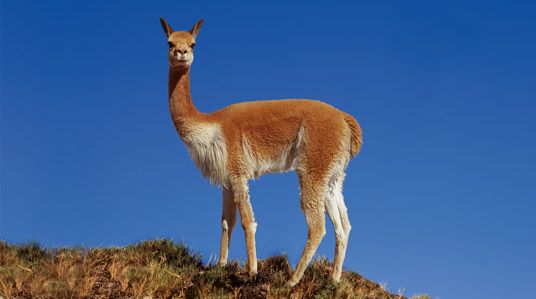The vicuña (Vicugna vicugna) is a fascinating animal native to the high-altitude regions of the Andes Mountains in South America. Renowned for their exquisite wool and graceful demeanor, vicuñas are not only an essential part of the Andean ecosystem but also hold significant cultural value. This article explores the biology, behavior, habitat, conservation status, and importance of vicuñas in human culture.
Characteristics
Vicuna are medium-sized camelids, closely related to llamas and alpacas. They possess several distinct characteristics:
- Physical Appearance: Vicuñas have long necks, slender bodies, and long legs, allowing them to navigate their mountainous habitat with ease. They typically weigh between 80 to 120 pounds (36 to 54 kg) and stand about 3 to 4 feet (0.9 to 1.2 meters) tall at the shoulder. Their coats are a warm tan color, with a cream-colored underbelly and distinctive white markings on their faces.
- Wool: Vicuñas produce one of the finest and most luxurious fibers in the world, known for its softness and warmth. This wool is highly sought after and has been traditionally harvested for thousands of years. Unlike domesticated llamas and alpacas, vicuñas can only be shorn every two to three years, making their wool exceptionally valuable.
- Adaptations: Vicuñas are well-adapted to their harsh environment, which includes high altitudes and extreme temperature fluctuations. They have specialized lungs for efficient oxygen intake, enabling them to thrive in the thin mountain air. Their hooves are also uniquely adapted for gripping rocky terrain.
Habitat
Vicuñas inhabit the high-altitude regions of the Andes, typically found at elevations ranging from 10,000 to 16,000 feet (3,000 to 5,000 meters) above sea level. Their preferred habitats include:
- Puna Grasslands: These areas are characterized by grasses and shrubs that provide sustenance for vicuñas. The puna grasslands offer the essential vegetation they need to thrive.
- Deserts and Steppes: Vicuñas are also found in arid regions where they can find adequate food sources. They are known to migrate to different areas in search of pastures during seasonal changes.
Behavior and Social Structure
Vicuñas are social animals that live in family groups, typically consisting of a dominant male, several females, and their young. Their social structure can be characterized by:
- Territoriality: Males are territorial and often engage in displays of dominance to protect their group. They use vocalizations and physical displays to assert their authority over others.
- Communication: Vicuñas communicate through a variety of vocalizations, including high-pitched sounds and alarm calls to alert the group of potential dangers. Their keen eyesight also helps them detect predators from a distance.
- Foraging: Vicuñas are primarily herbivores, feeding on grasses, leaves, and other vegetation. They have a unique grazing style, often using their incisors to clip grass close to the ground.
Conservation Status
Vicuñas have faced significant threats over the years, primarily due to habitat loss, poaching for their wool, and competition with livestock. As a result, their conservation status has fluctuated, leading to protective measures:
- IUCN Status: The International Union for Conservation of Nature (IUCN) lists the vicuña as Least Concern, but populations are still closely monitored.
- Legal Protection: Various countries, including Peru, Bolivia, and Chile, have implemented laws to protect vicuñas from poaching and illegal trade. These laws help regulate the harvesting of their wool and promote sustainable practices.
- Community Involvement: Indigenous communities in the Andes have played a crucial role in vicuña conservation. Programs that involve local populations in sustainable wool harvesting have proven effective in preserving vicuña populations while providing economic benefits to the communities.
Cultural Significance
Vicuñas hold a special place in the cultural heritage of the Andean people. Their significance includes:
- Historical Importance: The ancient Incas revered vicuñas for their luxurious wool, often using it to make garments for royalty. The importance of vicuña wool can be seen in historical artifacts and traditional clothing.
- Economic Value: Today, vicuña wool remains highly prized in the fashion industry, often fetching high prices in the market. Sustainable harvesting practices have allowed indigenous communities to benefit economically while ensuring the species’ conservation.
- Symbol of the Andes: Vicuñas are often regarded as symbols of the Andes and are celebrated in local folklore and art. Their graceful presence and beautiful wool continue to inspire cultural expressions in various forms.
Conclusion
Vicuna are remarkable animals that embody the beauty and resilience of the Andean highlands. Their unique adaptations, social structures, and cultural significance highlight the importance of conservation efforts to protect these gentle camelids. As we continue to navigate the challenges of habitat loss and climate change, the preservation of vicuñas will depend on sustainable practices, community involvement, and global awareness of their ecological and cultural value.
Understanding and appreciating the vicuña not only enriches our knowledge of biodiversity but also emphasizes the need for responsible stewardship of our natural resources. By supporting conservation efforts and promoting sustainable practices, we can help ensure that these magnificent creatures thrive for generations to come.










